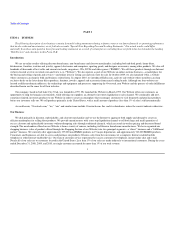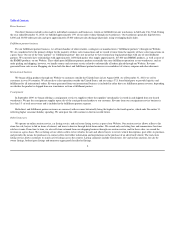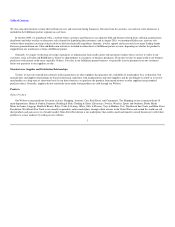Overstock.com 2010 Annual Report Download - page 17
Download and view the complete annual report
Please find page 17 of the 2010 Overstock.com annual report below. You can navigate through the pages in the report by either clicking on the pages listed below, or by using the keyword search tool below to find specific information within the annual report.
Table of Contents
which would adversely affect our profitability. Also, the timing of these expenses may contribute to fluctuations in our quarterly results of operations.
We may need to implement additional finance and accounting systems, procedures and controls as we grow our business and organization and to
satisfy new reporting requirements.
As a public reporting company, we are required to comply with the Sarbanes-Oxley Act of 2002 and the related rules and regulations of the SEC,
including expanded disclosures and accelerated reporting requirements and more complex accounting rules. Compliance with these and other new
requirements may increase our costs and require additional management time and resources. We may need to implement additional finance and accounting
systems, procedures and controls to satisfy our reporting requirements. If our internal control over financial reporting is determined to be ineffective, such
failure could cause investors to lose confidence in our reported financial information, negatively affect the market price of our common stock, subject us to
regulatory investigations and penalties, and adversely impact our business and financial condition.
Changes in accounting standards and subjective assumptions, estimates and judgments by management related to complex accounting matters could
significantly affect our financial results.
Generally accepted accounting principles and related accounting pronouncements, implementation guidelines and interpretations with regard to a wide
range of matters that are relevant to our business, including but not limited to, revenue recognition, estimating valuation allowances and accrued liabilities
(specifically, the allowances for returns, credit card chargebacks, doubtful accounts and obsolete and damaged inventory), internal use software and website
development (acquired and developed internally), accounting for income taxes, valuation of long-lived and intangible assets and goodwill, stock-based
compensation, and loss contingencies are highly complex and involve many subjective assumptions, estimates and judgments by our management. Changes in
these rules or their interpretation or changes in underlying assumptions, estimates or judgments by our management could significantly change our reported or
expected financial performance.
Our cash, cash equivalents, investments in precious metals and short-term investments are subject to a risk of loss based upon the solvency of the
financial institutions in which they are maintained and movement in the precious metals markets.
We maintain the majority of our cash, cash equivalents, investments in precious metals and short-term investments in accounts with major financial
institutions within the United States, in the form of demand deposits, money market accounts, time deposits, U.S. Treasury Bills and other short-term
investments. Our deposits in these institutions may generally exceed the amounts of insurance provided, or deposits may not at all be covered by insurance. If
any of these institutions becomes insolvent, or there is a significant decline in the price of precious metals, it could substantially harm our financial condition
and we may lose some, or all, of such deposits.
If we fail to accurately forecast our expenses and revenues, our business, prospects, financial condition and results of operations may suffer and the
price of our securities may decline.
Our limited operating history and the rapidly evolving nature of our industry make forecasting operating results difficult. Since 2005, we have completed
several large, complex and expensive infrastructure upgrades in order to increase our ability to handle larger volumes of sales and to develop or increase our
ability to perform a variety of analytical procedures relating to our business, and we are continuing the work to upgrade and further expand these and other
components of our infrastructure. We have experienced difficulties with the implementation of various aspects of the upgrades of our infrastructure, and have
incurred increased expenses as a result of these difficulties. As a result of these expenditures, our ability to reduce spending if our revenues are lower than we
project is limited.
11
























